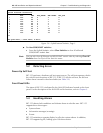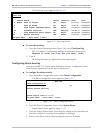
Port-Based Traffic Separation B-1
Appendix B
Traffic Separation
RIC-155 supports separation between Ethernet management and user traffic.
There are two traffic separation modes: port-based and port-based/VLAN-based.
The traffic separation mode depends on the forwarding mode of the internal
bridge:
• Filter – frames are received with VLAN tag or untagged, the bridge learns the
source address of the incoming frames, performs the bridging according to the
MAC address only. Traffic separation is port-based.
• Filter Tagged – the bridge separates management traffic from the user traffic
by the tags assigned to the frames. The bridge operation complies with the
relevant parts of IEEE 802.1Q. Traffic separation is port-based/VLAN-based.
B.1 Port-Based Traffic Separation
Port-based traffic separation is achieved by setting the physical port access to
None, MNG only (Ethernet Management only) or All.
None
When the physical port access is set to None, only the 10/100BaseT data port is
connected to the uplink port (Figure B-1). In this case, the local RIC-155 cannot be
managed from either the local DATA or MNG port. However, the remote RIC-155
unit can be managed via the NMS connected to the local DATA port, and the
remote unit can manage the local unit.
MNG Host
UplinkData
Figure B-1. Physical Port Access – None
MNG only
Setting the physical port access to MNG only, disconnects the local DATA port
from the local CPU, preventing the local RIC-155 from being managed via the
DATA port, but allowing management via the remote DATA port. At the same
time, both local and remote RIC-155s can be managed via the MNG port.


















